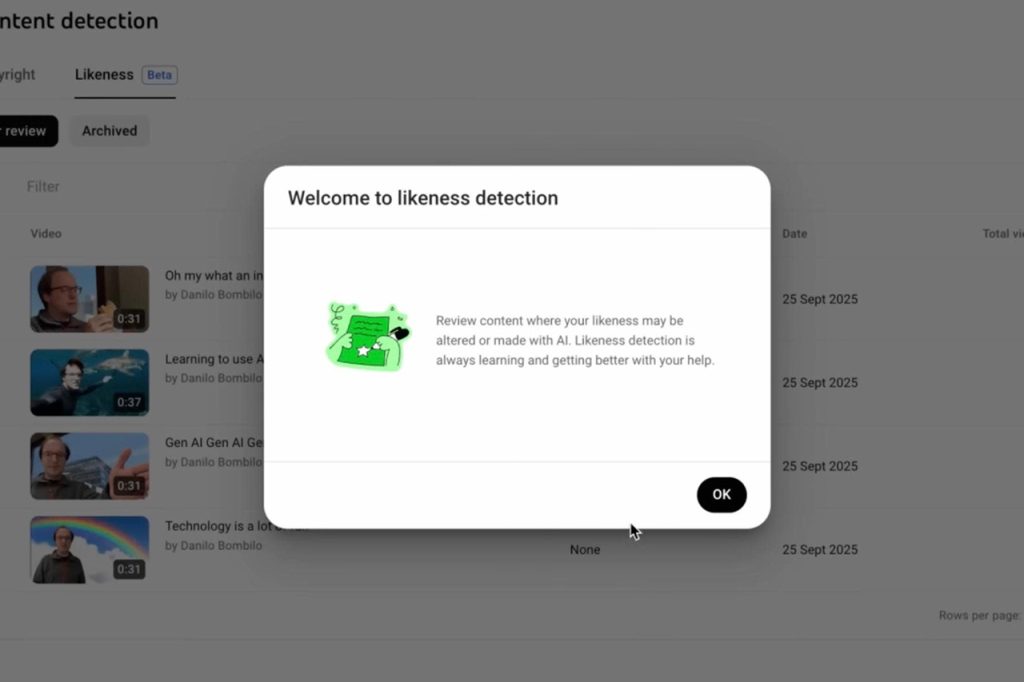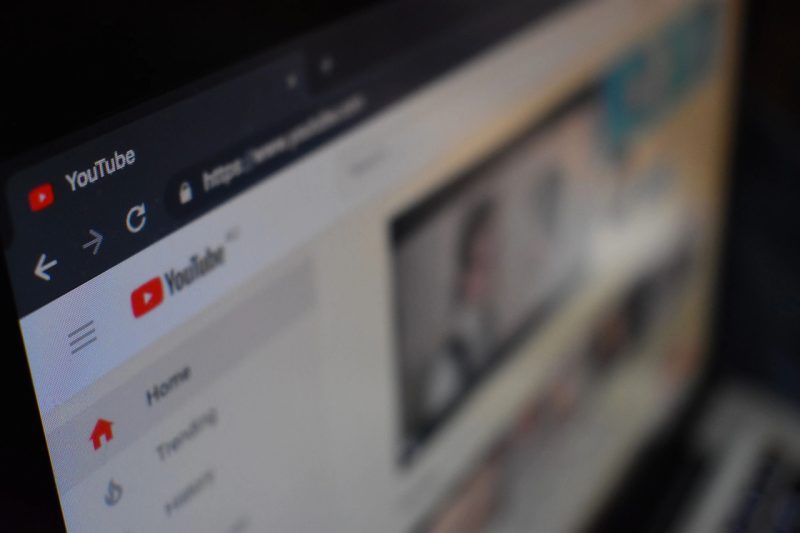YouTube has started rolling out an AI “likeness detection” feature to help creators find and take down videos that mimic their face—or use AI to make it look like they did or said something they didn’t. The first wave landed with selected members of the YouTube Partner Program, with emails going out and access appearing in a new Likeness area inside the Content detection tab of YouTube Studio. YouTube says more creators will get it over the next few months.
The news hasn’t come out of nowhere. YouTube teased the idea last year, then piloted it in December with talent represented by Creative Artists Agency. In September, at its Made On YouTube event, the company said it would expand access to Partner Program creators. Now we’re in that first public wave. Some reports even note a target of global access for monetized creators by January 2026, though that’s a plan, not a promise.
How it works
Here’s the basic flow. Inside YouTube Studio, there’s a Content detection section. You’ll see a Likeness option. To turn it on, you have to verify your identity, which means consenting to biometric processing, submitting a government ID, and recording a short selfie video. Once you’re approved, YouTube starts scanning newly uploaded videos on the platform to flag potential matches to your facial template.

A few practical notes from YouTube’s own help page: this is experimental; it won’t be perfect; and it may even surface your own real footage in the early phase. Also, it’s limited to select countries for now and requires you be over 18 and have the right role on the channel. If you don’t see matches, that might be normal—YouTube stresses that no matches can simply mean there aren’t any fakes of you up right now.
When the system flags a likely video, it shows up in your Likeness dashboard with details like title and channel. You can then review it and choose your next move. There are two main paths:
- Privacy removal request if the video uses an AI-altered likeness.
- Copyright removal request if someone also used your copyrighted content.
You can also archive it if you decide it’s not worth action. That workflow mirrors the way creators already escalate copyright issues—only this one is about identity and deception rather than reusing a clip.
YouTube says you can filter by total views or by the uploader’s subscriber count, which is handy when you’re trying to triage at scale. And if you decide you don’t want this feature after all, you can opt out; YouTube says scanning stops within about a day after you do.
Right now, likeness detection is aimed at the visual side. The help docs say it focuses on finding your face. If your voice is cloned but your face isn’t used, you can still file a privacy complaint—but the automated detection isn’t tuned for voice alone yet. Interestingly, YouTube notes it creates both face and voice templates during setup to improve detection, yet the FAQ makes clear the current emphasis is visual. That nuance matters if someone is using your voice to pitch a product you never endorsed.
What’s happening with data and storage
Let’s talk about the part that always makes creators pause: “So, what happens to my data?” YouTube states it uses your selfie video and your existing videos to create templates. Your full legal name is tied to the process, and the data can be stored for up to three years from your last sign-in, unless you withdraw consent or delete your account. That retention window gives the system continuity, but it also raises fair questions about control and comfort. If you withdraw consent, YouTube says it deletes the information and stops future detection.
Some commentators are already voicing concerns here. One analysis from MediaNama points to the tension: to protect your likeness, you need to hand over more of your likeness. That piece also flags open debates around fair use, parody, and what happens when the person is deceased. These aren’t settled issues, and they’ll test the trust folks place in both the policy and the process.
Why now? A quick tour of the bigger picture
The rollout sits inside a much broader push. YouTube requires creators to label realistic AI-altered media, and it has policies aimed at music that imitates an artist’s distinct voice. On the technical side, Google has been working on watermarking under the SynthID banner, plus a portal to detect those watermarks when present. Different tools solve different slices of the problem: watermark detection helps when content carries the mark; likeness detection helps when a fake exists with or without watermarks.
There’s a policy backdrop too. YouTube has publicly supported the proposed “No Fakes Act,” which would shape how platforms respond to unauthorized digital replicas. It won’t fix the internet overnight, but it does signal where platforms want clearer lines, and it shows why YouTube is building software to enforce those lines once they exist.
If you’re a creator, what changes?
Honestly, the first change is psychological. Knowing there’s a system scanning for your face won’t stop every bad actor, but it lowers the mental tax of not knowing who’s impersonating you this week. That matters. You can set up the tool, glance at the Likeness dashboard during your normal Studio routine, and escalate when something crosses a line. For creators with large audiences, even a single fake can snowball. This adds a speed bump.
The second change is operational. You’ll want a simple internal playbook: who checks the dashboard, how often, what “clear fake” looks like for your channel, when to file a privacy request, and when copyright also applies because someone lifted your original footage wholesale. If you’ve got a team, give them a shared definition of “harm.” Paid endorsement fakes deserve immediate action. Satirical remixes that are clearly labeled might be less urgent. That judgment call will never be perfect—but having a plan beats winging it.
A third change is community trust. Take a minute to tell your audience what you’re doing. A pinned comment, a short channel post, or a 30-second update on your next upload goes a long way. People don’t like being fooled; viewers will appreciate that you’re on watch.
What it still can’t do
No, this won’t catch everything. It’s focused on YouTube, not the broader web or other apps. And even on YouTube, early versions may mislabel real footage as a possible fake. YouTube warns about that; it’s part of why this is still framed as experimental. You’ll still need judgment, and at times you’ll still need to take manual steps.
Also, the rollout is staged. The first set of creators got access; more are coming; and yes, reports suggest full coverage for monetized channels could extend into early 2026. Plans can shift, so anchor your expectations in what you can do today: enroll, learn the workflow, and test your review process while the volume is manageable.
And here’s a subtle wrinkle: parody and commentary. Some critics worry the privacy route could be used to pull down satire that would be fair use under copyright. YouTube says it weighs factors like parody, satire, and disclosure in its assessments, but that debate isn’t going away. It’s a line we’re all still learning to draw.
Think about the old problem of email spam. We didn’t solve it with one perfect filter. We layered things. Reputation systems. Flags. Manual reporting. Then more AI. Likeness detection feels like that kind of layer. It won’t clean the pool by itself, but it changes the default posture: you’re not searching for fakes blind. The system brings possible messes to your doorstep, then gives you buttons to clean them up.
You know what? That alone lightens the load.
Where this fits with watermarking and authenticity labels
If you’ve followed watermarking efforts like SynthID, you might ask, “Why not rely on watermarks?” Watermarks help when the generator embeds a signal that detection systems can read later. But not every tool adds a mark, and not every mark survives editing. Likeness detection complements watermark checks by analyzing the content itself for the shape of your face. Over time, these layers—watermarks, authenticity labels like C2PA content credentials, and visual matching—should reduce the easy wins for bad actors. They won’t end fakery, but they raise the cost.
A short digression on culture and timing
This launch lands during a season when public trust feels fragile. We have voice clones pushing scams, fake endorsements spreading across short-form feeds, and AI music that sounds like the real thing. YouTube’s move is pragmatic: make a tool, test it with the folks likeliest to need it, then expand. There’s something quietly reassuring about that.
At the same time, policy folks are still negotiating where rights begin and end. The “No Fakes Act” hearings featured artists and executives urging lawmakers to protect people from unauthorized digital replicas. That tells you how serious the stakes feel beyond YouTube’s walls. Platforms can build tools. Laws can draw boundaries. Viewers, in the end, still decide who they trust.
So…what should you do this week?
First, if you’re in the YouTube Partner Program and got the email, set it up. Keep the process simple: verify, wait for approval, then check your Likeness dashboard once a day for a week to get a feel for the signal. If you didn’t get access yet, you can still tighten your own house:
- Add clear AI disclosures when your content uses synthetic media in a way viewers could mistake for real.
- Revisit your branding kit—intros, lower thirds, watermarks—so impersonators have a harder time stitching together convincing fakes.
- Tell your audience how to report fakes that they find.
When a flagged video appears, decide if it’s a privacy case, a copyright case, or both. Document a few examples for your team to reference later. Boring? Maybe. But future you will be grateful.
The policy gray zones you’ll bump into
Fair use and satire. News commentary that uses an AI filter for humor. Deepfake “what if” videos posted with disclaimers. In some countries, there are more protections for this type of speech; in others, fewer. YouTube says it considers parody, satire, and disclosure when it reviews privacy complaints. That doesn’t mean every decision will land how you want. It does mean you should include context when you file a request—why the content misleads, what the harm is, and whether there’s a clear intent to pass off the fake as you.
There’s also the question of voice-only fakes. If a video uses your cloned voice over generic visuals, it might not get flagged by the likeness detector yet. Still file. And if someone used your actual footage or audio, weigh a copyright claim too. A privacy claim addresses the impersonation; a copyright claim tackles unauthorized reuse. Both paths can apply.
What about false positives?
They’ll happen. YouTube even warns that the tool may surface videos with your real face, including clips of your own work. That’s not great, but it’s honest. In practice, you’ll get used to skimming and archiving. My suggestion is to note patterns—certain angles, lighting, or thumbnails that trip the system—and adjust your review habits. If it wastes too much time, pull back to scanning only the “high priority” items and the ones with lots of views.
A quick look at access and timeline
If you’re wondering, “When will I get it?”, the cleanest answer is: it’s live now for a set of eligible creators in the Partner Program, expanding over the coming months. The company previously said the tool would reach Partner Program creators more broadly after the pilot and reiterated that expansion at its September event. One trade publication also reported a January 2026 goal for all monetized creators worldwide. We’ll see how that shakes out, but the pattern is clear: staged access, then scale.
For the tech-curious: what’s under the hood?
YouTube hasn’t shared a white paper, but the behavior lines up with modern face-matching systems: build a template from verified imagery, then compare it against frames sampled from new uploads. The model flags likely matches for human review by the creator. It’s not unlike Content ID in spirit—fingerprints, scanning at upload, dashboards for rights holders—only this fingerprint is you. That shift from “this video is mine” to “this is me” is why identity verification is part of setup. It raises the bar for false claims and puts a name behind the template.
And yes, this coexists with Google’s other efforts like SynthID watermarking and the SynthID Detector portal announced earlier this year. Watermark detection is about provenance; likeness detection is about identity. Together, they cover more cases. Neither replaces your judgment.
A human note before we wrap
I’ll be honest: writing about face-matching tools makes me a little uneasy. The upside for creators is real. The potential for overreach is real too. If you’re feeling both, you’re not alone. The day-to-day fix is simple enough—use the tool, escalate the fakes, keep your audience in the loop. The longer-term fix is trust, which depends on how well YouTube enforces the rules and how transparent it is when things go wrong.
The encouraging part is the direction. We’re getting away from a shrug-and-hope posture to something more active: creators enroll, systems scan, flags appear, actions follow. It’s not magic. It’s work. But it gives you a lever.
A reasonable action plan
Enroll if you’re eligible. Learn the dashboard. Set a routine. Document a few examples of what you’ll remove and why. Tell your audience how to spot fakes fast. When voice-only fakes show up, use the privacy process and add context. Keep an eye on policy updates and legal changes; if the “No Fakes Act” or similar laws advance, platform responses may tighten. And if the system gets something wrong—too loose or too strict—say so. Product teams do listen when enough creators give clear, specific feedback.
Deepfakes mess with something basic: our sense that a face we trust belongs to a person we know. YouTube’s likeness detection won’t fix the internet, but it nudges the platform toward a fairer default—one where creators have a real chance to find fakes and push back. That’s worth using, and it’s worth watching closely.









